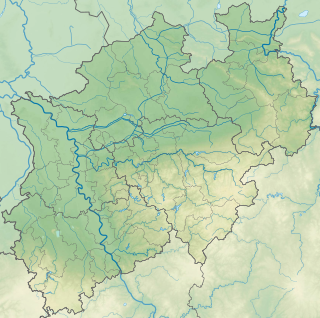Dhünn plateau
| Dhünn plateau | |||
|---|---|---|---|
| Systematics according to | Handbook of the natural spatial structure of Germany | ||
| Greater region 1st order | Low mountain range threshold | ||
| Greater region 2nd order | Rhenish Slate Mountains | ||
| Main unit group | 33 → Süderbergland |
||
| About main unit | 338 → Bergische plateaus |
||
| 4th order region (main unit) |
338.2 → Südbergische Plateau |
||
| Natural space |
338.20 → Dhünn plateau |
||
| Geographical location | |||
| Coordinates | 51 ° 4 '26 " N , 7 ° 12' 51" E | ||
|
|||
| local community | Wermelskirchen , Burscheid , Hückeswagen , Wipperfürth | ||
| state | North Rhine-Westphalia | ||
| Country | Germany | ||
The Dhünn plateau is according to the Handbook of the Natural Region Divisions of Germany a natural spatial unit with the number 338.20 and is one of the superior natural environment 338.2 ( Südbergische plateau ). It includes almost the entire urban area of Wermelskirchen , the Burscheider district of Hilgen , the west of Hückeswagen with the catchment area of the Purder Bach and parts of the Wipperfürth district of Wipperfeld in the Dhünntal north of the federal road 506 . The southern border of the natural area is formed almost separately by the river Große Dhünn from the source to the confluence of the Eifgenbach . After the Great Dhünntalsperre was dammed , half of it is now in the natural area. The northern border roughly follows the route of Federal Motorway 1 .
The Dhünn plateau is located south of the Remscheid highlands (order number 338.060) and the Lennep plateau (338.10) and borders the Wippermulde (338.12) in the east . In the Dhünntal, the Kürten plateau (338.220) and the Bechener plateau (338.21) join in the south ; in the east the Dhünn plateau merges into the Burscheider loess terraces (338.00).
The Dhünn plateau is a sloping plateau that drops from 320 to 330 m in the northeast at the Wippermuldenrand to 200 m in the southwest at the edge of the Burscheider loess plate. The plateau is finely structured by the deep stream valleys of the Great and Small Dhünn, the Eifgenbach, the Purder Bach and their numerous tributaries. The riedel plateaus, which run between the streams from northeast to southwest, are nonetheless connected, so that the continuous character of a plateau is not lost despite the intensely carved terrain structure. On the sloping, feather-shaped slashed and wide ridges run high trails like today's federal road 51 , which was already used in prehistoric times as the Cologne – Dortmund military route or the state road L101. The Dhünntal is cut 100 to 150 m deep and, like its side valleys, broad-bottomed and has steep slopes.
Geologically, the Dhünn plateau is part of the south wing of the Remscheid-Altenaer saddle . The rock consists mainly of clay slates from the Lower and Middle Devonian . The resistant Mühlenberg layers from Grauwacken are subordinate and not noticeable . The soils are mostly medium to shallow sandy-stony loams , which are unfavorable for the agricultural cultivation of crops . Therefore, in addition to areas for pasture farming, there are mainly large forest areas and industrially-related dense buildings along the high-altitude trails in the natural area. The larger settlements such as Wermelskirchen (core town) or Dabringhausen are also located there .
As part of the Regionale 2010 , the term Dhünn plateau became known to a broader public, as the project objective included, among other things, the tourist development and marketing of the natural area.
